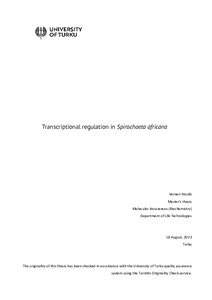Transcriptional regulation in Spirochaeta africana
Nissilä, Verneri (2023-08-22)
Transcriptional regulation in Spirochaeta africana
Nissilä, Verneri
(22.08.2023)
Julkaisu on tekijänoikeussäännösten alainen. Teosta voi lukea ja tulostaa henkilökohtaista käyttöä varten. Käyttö kaupallisiin tarkoituksiin on kielletty.
avoin
Julkaisun pysyvä osoite on:
https://urn.fi/URN:NBN:fi-fe20230904116583
https://urn.fi/URN:NBN:fi-fe20230904116583
Tiivistelmä
The genome sets the limits of how far the cells can differentiate or adapt; the extent to which either actually happens is the territory of transcription. The molecular mechanisms of transcription are well known for E. coli but recent data have shown that possibly important differences exist between the transcription machineries of bacteria. In this work, a hitherto unexplored transcriptional apparatus was investigated. Specifically, the Spirochaeta africana (sfc) RNAP and associated proteins were expressed heterogeneously and purified, and transcription templates were constructed that included a Broccoli sequence nested downstream from either the sfc rRNA promoter or the consensual Gre promoter. Transcription reactions were assembled in vitro and supplied with the fluorogen DFHBI-1T whose complex with the Broccoli transcript is fluorescent. The fluorescence from these assembled reactions was followed between 20-620 seconds post-initiation. The effect of two transcription factors (CarD and DksA) and a small molecule (guanosine tetraphosphate) were explored in different reactions. Factor independent transcription was stronger from the metabolic promoter (140% difference); CarD increased transcription from the rRNA promoter but decreased it from the metabolic promoter (+190% vs -40%). DksA decreased transcription from the rRNA promoter by 15% while no effect was verified for the metabolic promoter. With both promoters, equimolar amounts of CarD and DksA produced effects that were closer to the effect of CarD than that of DksA (total effects +155% vs -57%). The modulatory effect of ppGpp on CarD and DksA was studied in the context of the metabolic promoter; the effect of CarD was noted to be accentuated (+8%). Together, these data indicate three things. Firstly, the studied rRNA promoter is rate-limited by the formation of an open complex and that the metabolic promoters open complex is more stable. Secondly, an indication was found that the stress regulation of rRNA promoters in S. africana does not necessarily rely on DksA as in E. coli but perhaps CarD; similarity or the lack of it of the mechanism to that in play in other CarD-encoding bacteria, like Mycobacterium tuberculosis, remains to be verified. Finally, there might be a CarD-ppGpp axis that together is stronger than either of the components alone.
